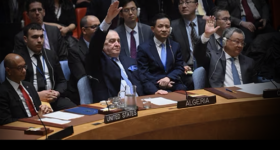21st Century Wire says…
Is Australia flexing its muscles, or just obeying US and British orders?
Deborah Snow
Bayside Bulletin
Military strategists love a neat metaphor and today’s defence white paper from the Gillard government has given us a new one to bandy about. The US had its “pivot” into the region. The white paper is asking us to envisage what it’s calling a “new Indo-Pacific strategic arc” stretching from India, through south-east Asia and north-east Asia, as our area of key strategic interest.
In essence, this means more emphasis on looking west and northwest towards the Indian Ocean as well as to the north and north-east – not a revolution, but an evolution of what has been going on quietly inside defence circles for some years…

Press Conference introduces the new Defence ‘Arc’ (Photo Source: SMH.com.au)
As University of New South Wales defence analyst Alan Dupont puts it, “What the government is saying here is that increasingly the Asia-Pacific [region] and Indian Ocean are being linked by trade, energy and security considerations; that’s essentially the message.” Personally, though, he is not enamoured of talk of “arcs”. “I think it is a poor choice of metaphors. The original reference [in a previous draft of the white paper] was to a unitary strategic system, and I think that’s a much better way of describing it. “Dupont also detects a political hand in the softening of Australia’s rhetoric towards China, compared with the more strident tone adopted in the Rudd government’s white paper of 2009. Punches have been pulled, not only about China, but about the very real tensions stemming from seemingly intractable maritime and territorial disputes, between China and nations such as Vietnam and the Philippines, between Japan and South Korea, and between Japan and Russia over the Kurile islands.
If anything, Dupont argues, the tone of this white paper has over-corrected and become too sanguine on the challenges these continuing disputes pose for anxious onlookers like Australia.
“Whoever has gone through the final draft, in a political office or whatever, they have taken out anything which looks a bit contentious,” he says. “It’s been so diluted now it’s almost anodyne.”
Despite these reservations, he believes the white paper is a reasonably balanced effort which will be broadly supported in many of its recommendations. There is a commendable focus on so-called “soft” defence power, that is strengthening what the strategists like to call “regional security architecture”: building up formal and informal defence links with countries in the region, providing a leg-up to the Pacific states with their maritime surveillance and importantly acknowledging Indonesia as “our most important defence relationship in the region”.
The government has heard the concerns of industry about the relative vulnerability of billions of dollars worth of oil and gas infrastructure on the north-west shelf and will increase its defence footprint there. One surprise is the renewed commitment to the 2009 white paper goal of acquiring 12 new submarines, up from our present six. This is a hugely expensive project, at least $36 billion just to purchase the vessels, let alone maintain and operate them. Dupont thinks ultimately a future government will have to walk away from 12 and look at nine, or less.















